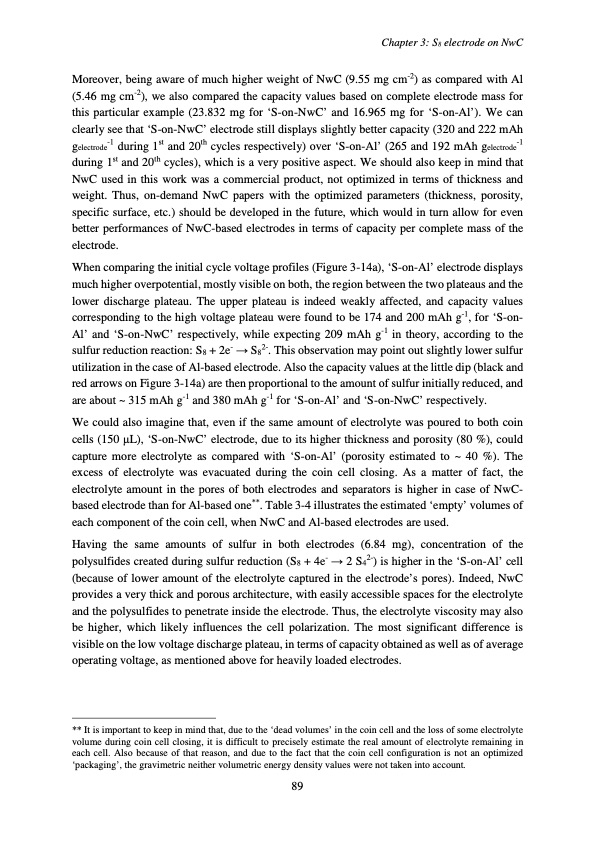
PDF Publication Title:
Text from PDF Page: 093
Moreover, being aware of much higher weight of NwC (9.55 mg cm-2) as compared with Al (5.46 mg cm-2), we also compared the capacity values based on complete electrode mass for this particular example (23.832 mg for ‘S-on-NwC’ and 16.965 mg for ‘S-on-Al’). We can clearly see that ‘S-on-NwC’ electrode still displays slightly better capacity (320 and 222 mAh gelectrode-1 during 1st and 20th cycles respectively) over ‘S-on-Al’ (265 and 192 mAh gelectrode-1 during 1st and 20th cycles), which is a very positive aspect. We should also keep in mind that NwC used in this work was a commercial product, not optimized in terms of thickness and weight. Thus, on-demand NwC papers with the optimized parameters (thickness, porosity, specific surface, etc.) should be developed in the future, which would in turn allow for even better performances of NwC-based electrodes in terms of capacity per complete mass of the electrode. When comparing the initial cycle voltage profiles (Figure 3-14a), ‘S-on-Al’ electrode displays much higher overpotential, mostly visible on both, the region between the two plateaus and the lower discharge plateau. The upper plateau is indeed weakly affected, and capacity values corresponding to the high voltage plateau were found to be 174 and 200 mAh g-1, for ‘S-on- Al’ and ‘S-on-NwC’ respectively, while expecting 209 mAh g-1 in theory, according to the sulfur reduction reaction: S8 + 2e- → S82-. This observation may point out slightly lower sulfur utilization in the case of Al-based electrode. Also the capacity values at the little dip (black and red arrows on Figure 3-14a) are then proportional to the amount of sulfur initially reduced, and are about ~ 315 mAh g-1 and 380 mAh g-1 for ‘S-on-Al’ and ‘S-on-NwC’ respectively. We could also imagine that, even if the same amount of electrolyte was poured to both coin cells (150 μL), ‘S-on-NwC’ electrode, due to its higher thickness and porosity (80 %), could capture more electrolyte as compared with ‘S-on-Al’ (porosity estimated to ~ 40 %). The excess of electrolyte was evacuated during the coin cell closing. As a matter of fact, the electrolyte amount in the pores of both electrodes and separators is higher in case of NwC- based electrode than for Al-based one**. Table 3-4 illustrates the estimated ‘empty’ volumes of each component of the coin cell, when NwC and Al-based electrodes are used. Having the same amounts of sulfur in both electrodes (6.84 mg), concentration of the polysulfides created during sulfur reduction (S8 + 4e- → 2 S42-) is higher in the ‘S-on-Al’ cell (because of lower amount of the electrolyte captured in the electrode’s pores). Indeed, NwC provides a very thick and porous architecture, with easily accessible spaces for the electrolyte and the polysulfides to penetrate inside the electrode. Thus, the electrolyte viscosity may also be higher, which likely influences the cell polarization. The most significant difference is visible on the low voltage discharge plateau, in terms of capacity obtained as well as of average operating voltage, as mentioned above for heavily loaded electrodes. ** It is important to keep in mind that, due to the ‘dead volumes’ in the coin cell and the loss of some electrolyte volume during coin cell closing, it is difficult to precisely estimate the real amount of electrolyte remaining in each cell. Also because of that reason, and due to the fact that the coin cell configuration is not an optimized ‘packaging’, the gravimetric neither volumetric energy density values were not taken into account. Chapter 3: S8 electrode on NwC 89PDF Image | Accumulateur Lithium Soufre

PDF Search Title:
Accumulateur Lithium SoufreOriginal File Name Searched:
WALUS_2015_archivage.pdfDIY PDF Search: Google It | Yahoo | Bing
Sulfur Deposition on Carbon Nanofibers using Supercritical CO2 Sulfur Deposition on Carbon Nanofibers using Supercritical CO2. Gamma sulfur also known as mother of pearl sulfur and nacreous sulfur... More Info
CO2 Organic Rankine Cycle Experimenter Platform The supercritical CO2 phase change system is both a heat pump and organic rankine cycle which can be used for those purposes and as a supercritical extractor for advanced subcritical and supercritical extraction technology. Uses include producing nanoparticles, precious metal CO2 extraction, lithium battery recycling, and other applications... More Info
| CONTACT TEL: 608-238-6001 Email: greg@infinityturbine.com | RSS | AMP |